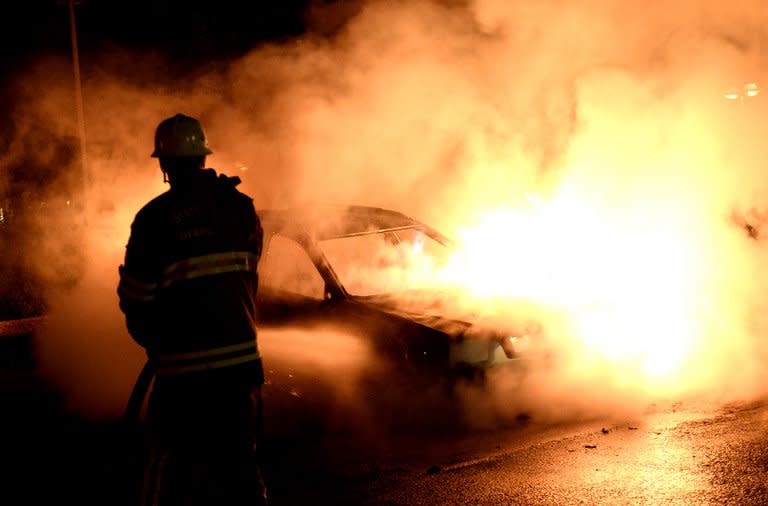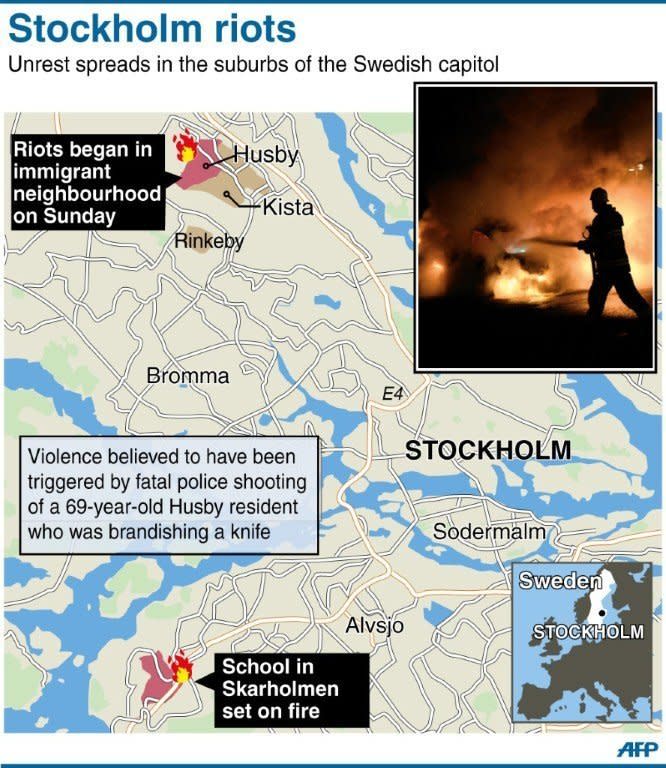Riots hit Stockholm suburbs for fourth night
Rioters torched cars and attacked local police stations in 15 immigrant-populated Stockholm suburbs in a fourth night of riots on Thursday, shattering Sweden's image as a peaceful and egalitarian nation. The riots have sparked a debate in Sweden about the assimilation of immigrants, who make up about 15 percent of the population, as many of them struggle to learn the language and find employment despite numerous government programmes. The fire brigade said it was called to some 90 different blazes during the night, most of them caused by rioters. Early Thursday, rocks were thrown at a local police station in the Kista district, near the suburb of Husby where the riots began on Sunday night, and rocks were thrown at two local police stations south of the Swedish capital. In the southern suburb of Skogaas, a restaurant was badly damaged after it was set ablaze. "We are gradually becoming more like other countries," said Aje Carlbom, a social anthropologist at Malmo University. The troubles are believed to have been triggered by the fatal police shooting of a 69-year-old Husby resident last week after the man wielded a machete in public. The man then fled to his apartment, where police have said they tried to mediate but ended up shooting him dead in what they claimed was self-defence. Local activists said the shooting sparked anger among youths who claim to have suffered from police brutality. During the first night of rioting, they said police had called them "tramps, monkeys and negroes." Two people, including one police officer, have been reported injured in the four nights of rioting. Police meanwhile downplayed the scale of the events. "Every injured person is a tragedy, every torched car is a failure for society... but Stockholm is not burning. Let's have a level-headed view of the situation," said Ulf Johansson, deputy police chief for Stockholm county. Residents of immigrant-populated areas are suffering from segregation, anthropologist Carlbom told AFP. "Living as a young person in these segregated areas can be very hard in many ways. You have virtually no contact with other Swedes and a lot of times I don't think you have a good understanding of Swedish society," he said. Sweden has in recent years been one of Europe's top destinations for immigrants, both in absolute numbers and relative to its size. In the past decade it has welcomed hundreds of thousands of immigrants from Iraq, Afghanistan, Syria, Somalia and the Balkans, among others. This is not the first time the Scandinavian country has seen riots among immigrants. In 2010, up to 100 youths threw bricks, set fires and attacked the local police station in the immigrant-heavy suburb of Rinkeby for two nights. And in 2008, hundreds of youths rioted against police in the southern Swedish town of Malmoe, sparked by the closure of an Islamic cultural centre in the suburb of Rosengaard that housed a mosque. Swedish Prime Minister Fredrik Reinfeldt on Wednesday blamed the recent violence on "hooligans" and said Thursday they were not representative of the majority in those areas. "I think it's dangerous to draw a picture of a Sweden with a capital separated from its suburbs. I don't think that's true. I think the dividing line runs straight through Husby, with a majority population and then a small group of troublemakers," Reinfeldt said in parliament. Integration Minister Erik Ullenhag meanwhile attributed the violence to high unemployment and social exclusion in Sweden's immigrant-dominated areas. "We know that there is discrimination in these areas, and these events don't improve the image of these areas, where there is a lot of positive stuff going but which is totally eclipsed right now," he told TT. In the suburb of Husby, overall unemployment was 8.8 percent in 2012, compared to 3.3 percent in Stockholm as a whole, according to official data. And a total of 12 percent in Husby received social benefits last year, compared to 3.6 percent in Stockholm as a whole. The riots have received international media attention, with some comparisons being drawn to similar problems assimilating immigrants in other European countries such as Britain and France.




